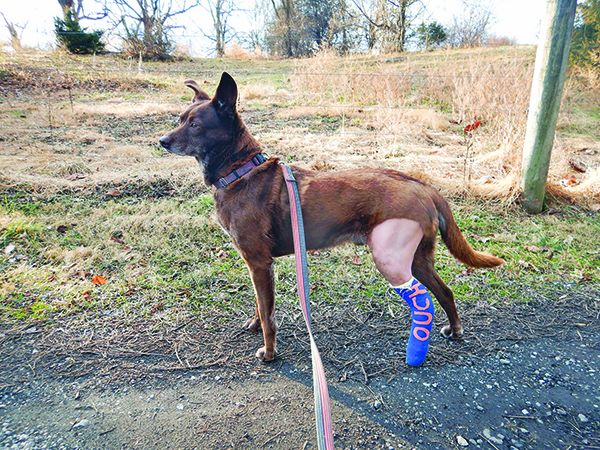
A few days after Christmas, my husband and I found ourselves facing a challenge: Our Australian Kelpie, Kai, was romping around the yard when suddenly he came up three-legged lame, putting no weight whatsoever on his left hind leg. Kelpies are an intense, high-energy herding breed (I describe them as “Border Collies on speed”), and though Kai is pretty good about short-term confinement, I suspected that he had torn his cranial cruciate ligament (CCL), which might require weeks of restricted activity.
It turned out that the injury was even worse than I initially thought. Radiographs showed a shattered calcaneus bone (pronounced “cal-kay-knee-us”) in his hock – and my veterinarian informed me that its repair would require the services of an orthopedic surgeon.
By some miracle, I found a veterinary practice with an orthopedist who could take Kai’s case right away. We rushed Kai to the clinic, an hour away, and returned home. The surgeon called later that afternoon and said the surgery had gone well, despite the fact that she had never seen a calcaneus shattered that badly, requiring wires and many tiny screws to put it back together. She added that I could pick up Kai the next day – and he would need six to eight weeks of restricted activity.
I suspected that such a lengthy period of inactivity would put even our good-natured, well-behaved Kelpie to the test. I began digging out all the enrichment toys I own and researching all the stationary exercises I could think of.
Three weeks and three bandage changes into his incarceration, Kai’s leg is healing well. I’m feeling confident enough in the canine-brain-tiring tactics I’ve undertaken to keep Kai quiet that I’m sharing them with you! I hope you don’t have a medical reason to have to put them to use – inclement weather that keeps you cooped up would be a “better” reason! – but if you do, at least a few of these tools and stratagems should work for you and your dog.
WORK FOR FOOD
I’m a big fan of food-dispensing toys that can be given to bored dog to roll around, such as the Roll-A-Treat Ball. But in this case, food-dispensing toys that move are verboten, since the patient is not supposed to move around much. Fortunately, there are plenty of options for stationary treat-containing toys and puzzles:
* Kong. The classic Kong toy, made by the Kong Company, is a well-established favorite of many dog owners and trainers. While some people stuff them with kibble and glue it in place by stirring in some peanut butter or yogurt, I like to stuff Kongs with Kai’s moist, home-cooked food, which doesn’t work well in most treat-dispensing toys.
To make extracting the food take even longer, fill the Kong with moist food (canned, home-prepared, or rehydrated) and freeze the stuffed Kong overnight.
* Toppl. Made by West Paw Design, the Toppl is another chew-resistant toy that can be stuffed with a home-prepared moist diet. The opening to these toys is wider than the opening of a Kong, which makes it easier to stuff, clean,and for the dog to lick out all the food.
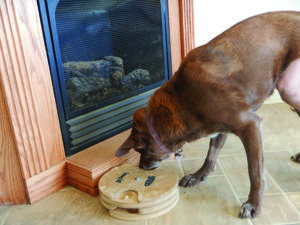
* Puzzle toys. Swedish native Nina Ottosson had two Bouvier des Flandres that she used to train and show, but after having two babies a year and a half apart, she found herself trying to devise toys to keep her dogs occupied with less actual time to exercise them. She crafted wooden puzzles that contained hidden compartments that held treats, which could be revealed and eaten by a dog who pushed levers, lifted blocks, turned discs, and so on.
Ottosson’s inventions worked so well, she started a company to manufacture and sell them. Eventually, she licensed Outward Hound to make plastic versions of her designs. I have a tub full of Ottosson’s original wooden puzzle toys, as well as some of the newer plastic ones from Outward Hound – and Kai is getting to play with all of them!
A decade ago, puzzle toys for dogs were a rarity. Now the market is flooded with them, some quite innovative. The mental exercise they provide can be as tiring as physical exercise. Do an internet search for “dog puzzle toys” and see what you get!
You can see my review of Nina Ottosson’s original wooden toys in the June 2008 issue of WDJ (“A Puzzling Activity”). For other interactive toy suggestions, see “The Best Food-Dispensing Toys,” WDJ April 2019.
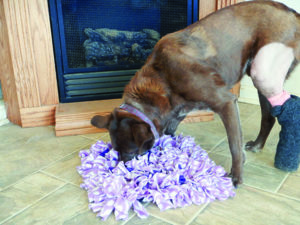
* Snuffle mats. These are another of my favorite relatively new additions to the dog-training world, available in astonishing variety. If you feed dry food, you can feed your dog’s meals in these. I put multiple small treats in mine for Kai to find and he loves the search.
* Slow feeder bowls. These are bowls with deep grooves or other obstacles so your dog has to work to get the food out. I’ve just ordered one for Kai. For a review of some different designs, see “Savor the Flavor,” WDJ November 2020.
* DIY Muffin Tin. Kai’s having fun with this one too – and I can feed his meals in it. Just take a muffin tin, drop treats or smear moist food in the cups, and cover the cups with tennis balls. Then let him work at removing the balls from the cups to access the treats underneath.
COGNITION GAMES
Games that require a lot of mental problem-solving are perhaps even more tiring for dogs than they are for us! Fortunately, they can be just as entertaining as they are exhausting for a convalescing dog.
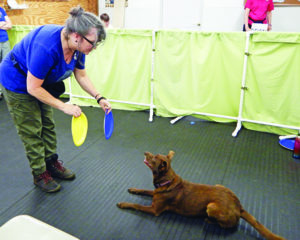
* Color discrimination. Yes, you can teach your dog to recognize colors! Then you can ask him to touch a target of a specified color or fetch a ball of a certain color. Dogs see blue and yellow well, so those are the best colors to work with. It’s thought that dogs see other colors as shades of brown, so you could add one more color (and perhaps black and white).
Start by asking your dog to “Wait,” then present one color (I use colored paper plates). If I was teaching a dog to identify blue, I’d say “Blue,” pause, and then say “Touch” (you want “Touch” to be the cue, not “Blue”).
Next, repeat the same process with yellow.
After several repetitions with each color individually, present both colors and ask him to touch one color. (If he heads for the wrong one just whisk it away, reset, and try again.) At first, position the one you’re going to ask for a little closer to your dog. As he is consistently successful at touching the color named, gradually present the two choices more evenly, until he can select the correct color without the offset assistance.
* Shape discrimination. Teach your dog the word for a few basic shapes. The process is the same as with colors. Present one shape first and name it, then present the other, and then the two shapes together, offset at first.
* Object discrimination. Dogs can also learn the word for some basic items, whether it’s a variety of toys (such as ball, disk, bone, or toy alligator). Kai is pretty good at indicating named objects, such as Ball, Roomba, and Stuffy.
No surprise – the process is the same as above. Present one object and name it, then present the next object, and then the two objects together, offset at first.
For more detail on how to teach these cognitive discrimination games, see “Are Canines Cognitive?” WDJ October 2017.
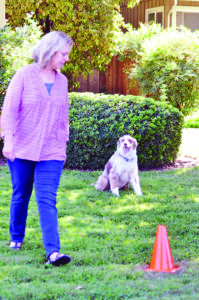
* Imitation. Teach your dog to “do what you do,” imitating movements such as a bow, a yawn, or a comically vigorous “no” nodding of the head. This is a much more complex cognitive challenge – and more brain-tiring than the discrimination exercises.
Here’s a simplified description of how to train this: It’s easiest if you start with a behavior he knows well on verbal cue. Let’s use “spin” as an example. Have your dog wait in his starting position while you demonstrate the human version of a “spin.” Return to your start position, say “Copy!” Pause for a second or two, then give his cue for the “spin” behavior. Repeat up to three times in a row.
Then, repeat the process with a second behavior – say, backing up. Ask him to wait in a starting position, back up yourself, say “Copy!” pause, and then give his cue for “back up.” Repeat this a few times.
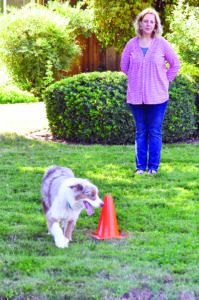
Then, repeat the process with a third behavior.
Finally, start randomly alternating these until he starts to offer the correct behavior on the “Copy” cue without needing the verbal cue for that behavior.
Note: If you continue with the same behavior too many times in a row, he will just think “Copy” is a new cue for the behavior you’re demonstrating, rather than a new training concept.
For a more complete description of the imitation protocol, see “Train Your Dog Using Imitation,” WDJ October 2013.
* Counting. This is definitely an upper-level cognition game. A protocol for teaching “quantity recognition” was developed by noted trainer Ken Ramirez, the former executive vice president of animal care and training at the Shedd Aquarium in Chicago, now the executive vice president and chief training officer with Karen Pryor Clicker Training. Here’s a very simplified explanation of Ramirez’s protocol:
The dog’s “answers” of one through five are made available to him in the form of small boards that are sprinkled with one, two, three, four, or five black dots. The “question” is put to the dog in the form of a tray, upon which are arranged one, two, three, four, or five items. The dog is shown the tray, laden with objects, and then asked “How many?” The dog indicates the number of items he saw on the tray touching the board with the same number of dots.
To see a couple of videos of Ramirez discussing this brain-game, see kenramireztraining.com/media/.
TRAINING GAMES
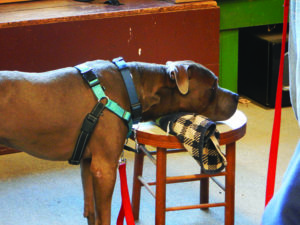
You can also enrich your dog’s restricted environment by training him to do a variety of stationary behaviors, such as:
• Paw Targeting: Teach him to touch his paw to a designated target.
• Nose Targeting: Teach him to touch his nose to a designated target. (When he knows paw and/or nose targeting you can teach him more low-activity fun stuff like pushing a talking button or light button, and playing a kiddie piano.)
• Say “Yes” and “No” – Teach him to nod his head up and down and to shake his head left and right.
• Wait: Teach him to not eat a treat within reach until you give him permission.
• Balance a Treat on Your Nose: This is easiest if he already knows “wait.” Then start with the treat at the bridge of his nose (between his eyes). As he grows more advanced at holding still, you can gradually move the treat toward the tip of his nose.
This is a great opportunity to work on useful cooperative-care procedures such as the Bucket Game (featured in “Care to Cooperate,” WDJ February 2021) or a “chin rest,” where he’d rest his chin on a rolled-up towel while you perform an exam or husbandry procedures. Both a chin rest and the Bucket Game are performed with the mutual understanding that you will stop the procedure if he looks away from the bucket or lifts his chin off the towel. He learns that you will not proceed until he gives the “okay to continue” signal of looking at the bucket or resting his chin again.
JUST WALK
Though Kai is not supposed to exercise, he does have to walk to go to the bathroom several times a day. So I figure that we might as well make use of these bathroom breaks as best we can, with a calm, quiet, slow on-leash walk.
Accustomed to ripping through the woods and across the fields at top speed when we go hiking, Kai is tolerating these short walks and I am loving them. It amazes me that he likes to stand like a statue and just look at and smell our surroundings, for minutes at a time, only his nostrils moving as he picks up scent and watches for movement. He has always enjoyed scent work, and it’s fun to watch him detect and follow a scent. Sometimes I go outside before I take him out and “salt” our walking path with treats for him to find.
REWARDING TIME
Whatever you do to pass this quiet time with your convalescing dog, rather than agonizing over the pain of managing her restricted activity, try to breathe deeply and enjoy doing enrichment activities with your dog. You might find out later that this was some of the most rewarding time you’ve spent together.






This is a wonderful article with such great suggestions for canine cognitive enrichment and I have tried and still use many of them. Unfortunately, my dogs (ridgebacks) often “solve” the puzzle toys by picking them up and just letting the treats fall out. OMG, they’re too smart for MY own good 🙂 Thanks for the treat toy suggestions.
I enjoyed this article very much and love the innovative ways the author described to engage a dog’s mind.
My Border Collie, Sheppie, used to cast a jaundiced (figuratively) eye on my other Border Collie, Raleigh Wood, as he diligently worked at solving their Nina Ottosson puzzles. When it was Sheppie’s turn (they alternated turns), she would walk up to the puzzle, grab it by the edge, shake it, and toss it as high as she could. All the treats would fly out, and she’d then dash around and snap them up while daring Raleigh Wood to try and snatch even one!
I am fortunate in not having to keep my dog (or former dogs) quiet. But I had to come up with a fix to prevent my lab mix that I just adopted in October from swallowing his kibble whole. Hes not a big water drinker, so after an incident where he stopped eating for about 16-18 hours – the light dawned & I changed how I feed him. I use his stainless dish & put a small pottery dish upside down in the middle. I pour a little chicken broth or stock (low salt) on dog food & cover with boiling water & let it sit. He gets Springtime supplements so mix those in & pour around the “trough”. Put a spoon of pumpkin on the bottom of the pottery bowl & thats it. I kind of think I could do without the middle dish by now, but it works & its no big deal . This way he doesnt swallow hard little food pieces whole AND he gets the liquid that he doesnt get by drinking water! Axel, this dog & my former lab mix make rescue & adoption the best ever. Actually, almost all of my dogs came to me that way & made my life so very much better – which is what dogs do!
I love your food toy suggestions. The rest of your ideas are great but don’t think any of them will work with Little Bit, my blind and deaf 19 yr old peekapoo. He sleeps most of the day. His only real joy is the walks we take. He does more time sniffing than he does walking. If you have any other suggestions you think will benefit him I would love to read about them.
This article could not have come at a better time. Our Callie, a Goldendoodle, Just had the exact same surgery two weeks ago. Although her hock was not shattered but did require a screw and cast right rear leg exactly as Kai. We’re not sure how she did it but romping with the neighbors visiting dog was the catalyst. The suggestions are wonderful brain training for her. I have a couple of Nina Ottosson’s toys which Callie enjoys and will be looking for a couple mentioned to keep her from being so bored. Thank you for the suggestions and we hope your Kai heals quickly and helping us to keep our Callie happy while recovering.
UPDATE; Callie is undergoing a second surgery in the same area. Apparently we haven’t kept her calm enough, and she hasn’t lost that much weight which adds pressure to the injured hock and tendon. I am heart broken she has to endure another surgery.
Colleen, so sorry to hear your dog is having such difficulty. Was any medication prescribed after the first surgery to keep her calm? I know it may not be the norm for orthopedic surgeries, but a previous dog of ours who had spine surgery was given trazodone to keep her quiet during recovery, as not doing so would have had very serious consequences. I also know someone whose rescued off the street Jack Russell was given trazodone to keep him quiet while on crate rest for the horrendous heartworm infection he was found with. Again, too much activity would have killed him. If dogs who have ligament and bone repairs are not being given something to help reinforce the restricted activity mandate, it is a disservice to both the dog and the owner, especially since those dogs are so often high energy breeds to start with. Ask your surgeon for more help with this situation the second time around.
We did get a prescription to calm Callie down. Between the medication I use a couple drops of Rescue Remedy and found it worked just as well as the Trazodone. Callie is now in her final weeks of healing since they removed the wire from her second surgery. Between the Covid-19 2020 year and her injuries, we have regressed and are now committed in helping her to get back on track. She is a high energy dog.
I have a 5 yo gsd that is having back surgery for a herniated disc and so many of these ideas I can do with her. Thanks